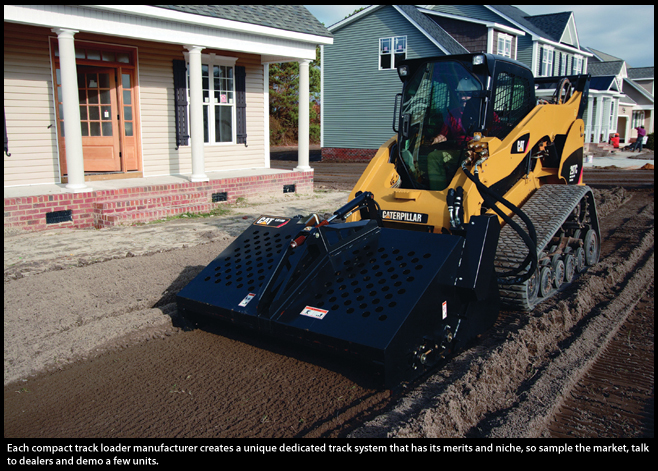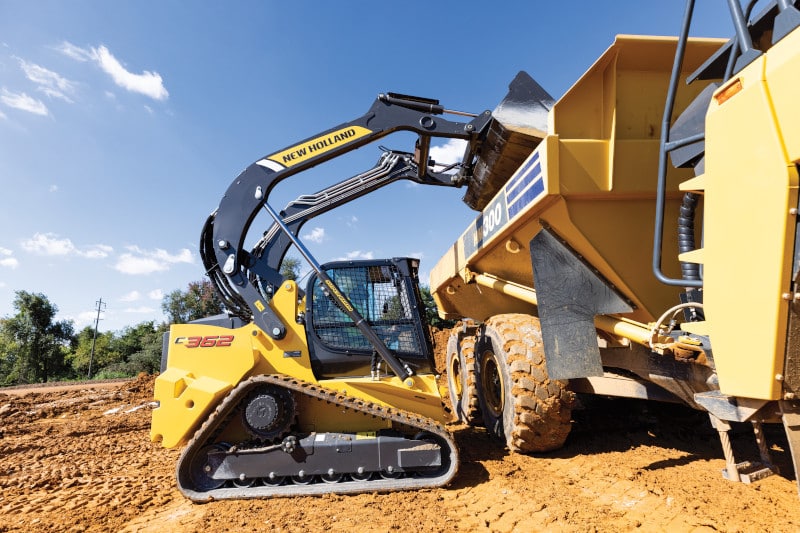Mud on the Tracks
The spring monsoon season always makes finishing those first construction and landscape projects of the year a constant challenge. The wet weather makes jobsites slick and unworkable, and your skid steers get no traction on those slippery inclines and delicate work surfaces. Your traditional wheeled loaders just end up flinging sod at coworkers, skidding around finely manicured lawns and tearing everything to hell.
That’s why it’s time to call in the mobile artillery — your little Sherman tank on tracks — your compact track loader. Tackling tough terrain and giving extra power are what compact track loaders are all about. Sometimes called rubber track loaders or multi-terrain loaders (depending on the manufacturer), these compact loader/tool carriers are engineered just like your skid steers (including the same attachment plate), but with the added versatility of a dedicated track undercarriage.
Rolling on rubber or steel tracks, compact track loaders can spearhead operations and navigate jobsites with extra flotation — especially in the wet weather months. A dedicated undercarriage also gives added tractive power (great in dozing operations), yet dispenses the weight of the entire machine through multiple track contact points for a lighter footprint. Extra power, lower ground pressure and added flotation and traction — the advantages of compact track loaders are growing on all types of professionals.
More and more customers are realizing the benefits of compact track loaders, including minimal ground disturbance for work on improved surfaces, smoother travel at higher speeds for work on unleveled sites, low center of gravity for work on side hills and overall improved productivity.

Compact track loaders have discovered some big markets — landscape, forest and construction jobs that need extra flotation, traction and pushing power (while still leaving a light footprint). Wheeled skid steers will always have their strong markets (especially when hard surfaces, cost of ownership or increased cycle times come into play), but compact track loaders continue to eat up market share in their specific applications. With such impressive market growth always comes increased competition and customers, which is why so many manufacturers have begun selling their own unique lineup of compact track loaders in the last few years.
From Bobcat to Caterpillar, Takeuchi to Terex, Komatsu to Case — more than 10 manufacturers are producing or branding these dedicated track machines today. Large or small, vertical or radial lift, enclosed cab or just ROPs, basic or opulent, suspension or no suspension, cheap or expensive — today’s market offers a wealth of choices for buyers. Overall, units range from 30 to 100 hp and operating capacities from 500 to 2,800 lbs (remember, that’s rated at 35 percent tipping load — not 50 percent like skid steers). Mid-size loaders are generally the most popular machines, because they are generally big enough to handle most jobs, yet compact enough to get into small spaces.
The undercarriage is as important to the machine as the attachment or engine. It is the combination of components that brings the machine to its assigned task. Without the undercarriage, a compact track loader can do limited work, similar to a car with flat tires. Extra power, lower ground pressure and added flotation and traction — the advantages of compact track loaders can add ammo to any contractor’s arsenal.
Keith Gribbins is managing editor for Compact Equipment, based in Peninsula, Ohio.





